Financial Decision Making Report: Accounting and Finance in SKANSA PLC
VerifiedAdded on 2023/01/06
|13
|3985
|42
Report
AI Summary
This report provides a comprehensive analysis of financial decision-making within SKANSA PLC, a construction company. It begins with an introduction to financial decision-making and its importance, followed by an evaluation of the accounting and finance functions, roles, and duties within the company. The report then delves into a detailed analysis of key financial ratios, including Return on Capital Employed, Net Profit Margin, Current Ratio, and Average Receivable Days, calculated for the years 2018 and 2019. These ratios are used to assess the company's financial performance, liquidity, and efficiency. The report also provides a commentary on the performance of SKANSA PLC, comparing its position between the two years. The conclusion summarizes the key findings and insights from the analysis, highlighting the significance of financial planning and management in achieving business goals. Finally, references are provided to support the information presented in the report.

Financial Decision
Making
Making
Paraphrase This Document
Need a fresh take? Get an instant paraphrase of this document with our AI Paraphraser
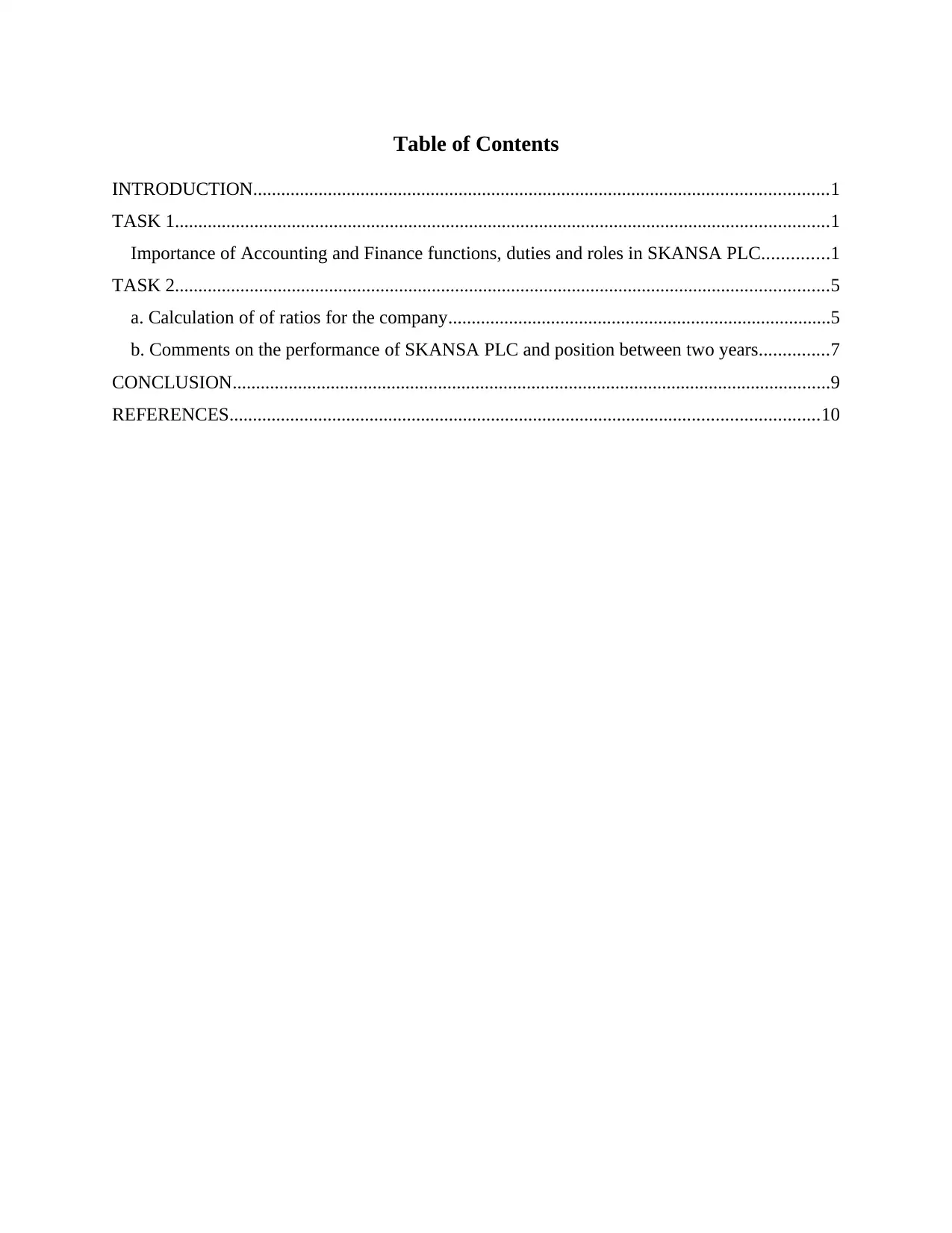
Table of Contents
INTRODUCTION...........................................................................................................................1
TASK 1............................................................................................................................................1
Importance of Accounting and Finance functions, duties and roles in SKANSA PLC..............1
TASK 2............................................................................................................................................5
a. Calculation of of ratios for the company..................................................................................5
b. Comments on the performance of SKANSA PLC and position between two years...............7
CONCLUSION................................................................................................................................9
REFERENCES..............................................................................................................................10
INTRODUCTION...........................................................................................................................1
TASK 1............................................................................................................................................1
Importance of Accounting and Finance functions, duties and roles in SKANSA PLC..............1
TASK 2............................................................................................................................................5
a. Calculation of of ratios for the company..................................................................................5
b. Comments on the performance of SKANSA PLC and position between two years...............7
CONCLUSION................................................................................................................................9
REFERENCES..............................................................................................................................10
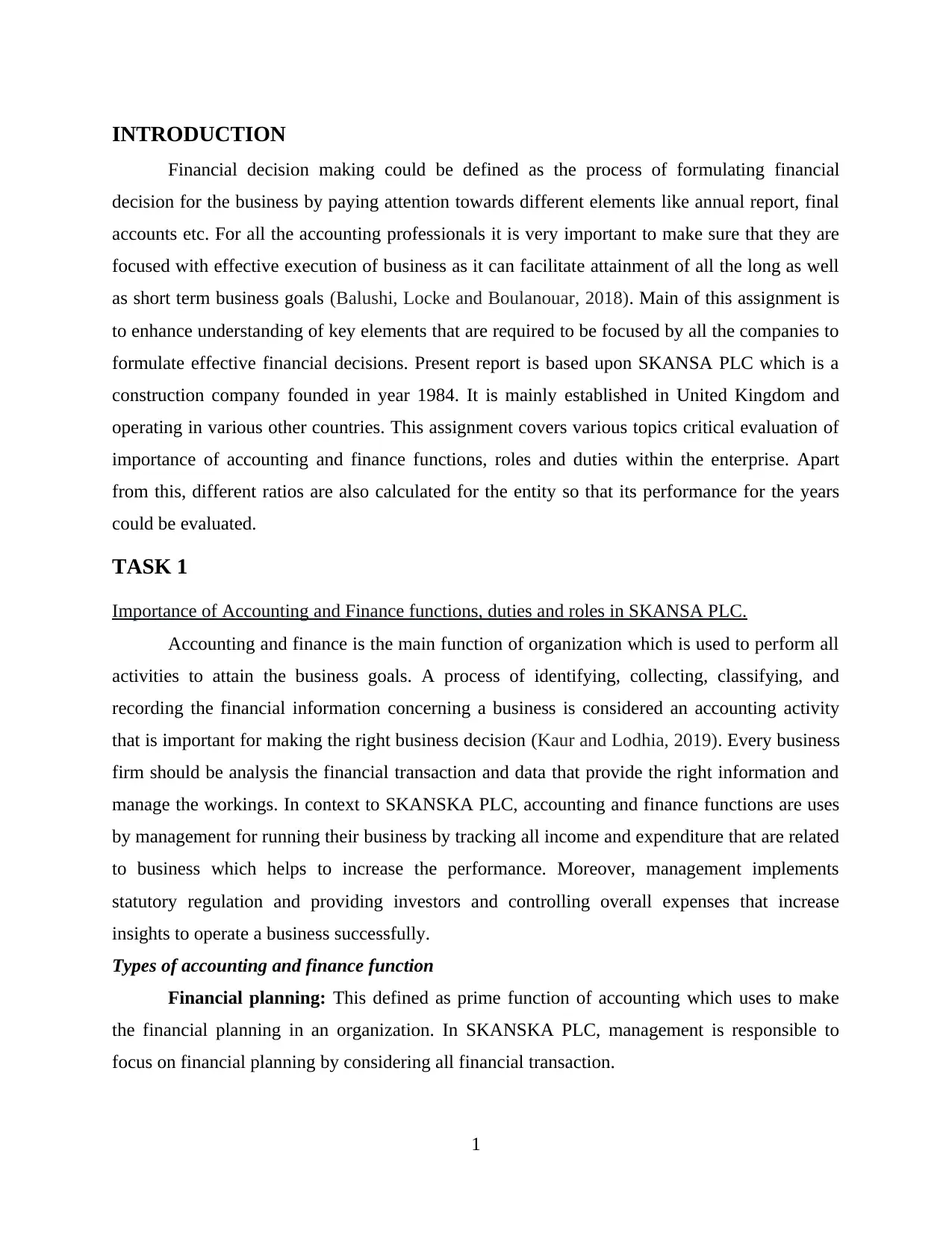
INTRODUCTION
Financial decision making could be defined as the process of formulating financial
decision for the business by paying attention towards different elements like annual report, final
accounts etc. For all the accounting professionals it is very important to make sure that they are
focused with effective execution of business as it can facilitate attainment of all the long as well
as short term business goals (Balushi, Locke and Boulanouar, 2018). Main of this assignment is
to enhance understanding of key elements that are required to be focused by all the companies to
formulate effective financial decisions. Present report is based upon SKANSA PLC which is a
construction company founded in year 1984. It is mainly established in United Kingdom and
operating in various other countries. This assignment covers various topics critical evaluation of
importance of accounting and finance functions, roles and duties within the enterprise. Apart
from this, different ratios are also calculated for the entity so that its performance for the years
could be evaluated.
TASK 1
Importance of Accounting and Finance functions, duties and roles in SKANSA PLC.
Accounting and finance is the main function of organization which is used to perform all
activities to attain the business goals. A process of identifying, collecting, classifying, and
recording the financial information concerning a business is considered an accounting activity
that is important for making the right business decision (Kaur and Lodhia, 2019). Every business
firm should be analysis the financial transaction and data that provide the right information and
manage the workings. In context to SKANSKA PLC, accounting and finance functions are uses
by management for running their business by tracking all income and expenditure that are related
to business which helps to increase the performance. Moreover, management implements
statutory regulation and providing investors and controlling overall expenses that increase
insights to operate a business successfully.
Types of accounting and finance function
Financial planning: This defined as prime function of accounting which uses to make
the financial planning in an organization. In SKANSKA PLC, management is responsible to
focus on financial planning by considering all financial transaction.
1
Financial decision making could be defined as the process of formulating financial
decision for the business by paying attention towards different elements like annual report, final
accounts etc. For all the accounting professionals it is very important to make sure that they are
focused with effective execution of business as it can facilitate attainment of all the long as well
as short term business goals (Balushi, Locke and Boulanouar, 2018). Main of this assignment is
to enhance understanding of key elements that are required to be focused by all the companies to
formulate effective financial decisions. Present report is based upon SKANSA PLC which is a
construction company founded in year 1984. It is mainly established in United Kingdom and
operating in various other countries. This assignment covers various topics critical evaluation of
importance of accounting and finance functions, roles and duties within the enterprise. Apart
from this, different ratios are also calculated for the entity so that its performance for the years
could be evaluated.
TASK 1
Importance of Accounting and Finance functions, duties and roles in SKANSA PLC.
Accounting and finance is the main function of organization which is used to perform all
activities to attain the business goals. A process of identifying, collecting, classifying, and
recording the financial information concerning a business is considered an accounting activity
that is important for making the right business decision (Kaur and Lodhia, 2019). Every business
firm should be analysis the financial transaction and data that provide the right information and
manage the workings. In context to SKANSKA PLC, accounting and finance functions are uses
by management for running their business by tracking all income and expenditure that are related
to business which helps to increase the performance. Moreover, management implements
statutory regulation and providing investors and controlling overall expenses that increase
insights to operate a business successfully.
Types of accounting and finance function
Financial planning: This defined as prime function of accounting which uses to make
the financial planning in an organization. In SKANSKA PLC, management is responsible to
focus on financial planning by considering all financial transaction.
1
⊘ This is a preview!⊘
Do you want full access?
Subscribe today to unlock all pages.

Trusted by 1+ million students worldwide

Managerial accounting: It is the procedure of creating document and preparing reports
in relation to business. The management of SKANSKA PLC perform this function for making
the right business decision by preparing financial reports (Elbayoumi, Awadallah and Basuony,
2019).
Fund flow statement: This defined as financial document of organisation which uses by
chosen organisation to analyse company's balance sheet for the purpose of raising funds.
Cost accounting: This is another function of accounting which uses by SKANSKA PLC
for calculating the cost of specific project by involving all income and expenses.
Importance of Accounting and finance functions
Tracking income and expenses: Accounting and finance is the main function of any
organization which uses to analyse the income and expenses that occurred in business. This is
important for organisations to identify the expenses and manage the workings. In SKANSKA
PLC, management uses accounting and finance for tracking the income as well as expenses that
help to increase the profitability (Oktyawati and Fajri, 2019).
Proper planning for business: Finance and accounts is needed in organisation as it
helps to formulate the proper plans and strategies that can help to increase the workings in a
competitive market and complete the task. In SKANSKA PLC, accounting is much needed for
completing the various management activities successfully. In this, management mainly focuses
on cash planning, sales, development of business, fixing the target profits, and determining the
stock quantity which helps to manage all information.
Allocation of budget and resources: Different functions are needed to perform in
organization where it is important for management to make the uses of accounting and financial
data that can help to complete the task. The financial managers of SKANSKA PLC use finance
in allocating the budget and resources according to activities that can help to manage the
workings and complete the project on time (Karagiorgos, Alexandra, Ignatiou and Terzidou,
2020).
Outlining Long term goals: Organisation aims to grow and scale their activities high.
To do so, management is required to formulate long term plan considering more than 5 years that
helps to attain higher profitability. In SKANSKA PLC, management uses accounting and
financial information for expanding business and achieving the business goals. This tells where
2
in relation to business. The management of SKANSKA PLC perform this function for making
the right business decision by preparing financial reports (Elbayoumi, Awadallah and Basuony,
2019).
Fund flow statement: This defined as financial document of organisation which uses by
chosen organisation to analyse company's balance sheet for the purpose of raising funds.
Cost accounting: This is another function of accounting which uses by SKANSKA PLC
for calculating the cost of specific project by involving all income and expenses.
Importance of Accounting and finance functions
Tracking income and expenses: Accounting and finance is the main function of any
organization which uses to analyse the income and expenses that occurred in business. This is
important for organisations to identify the expenses and manage the workings. In SKANSKA
PLC, management uses accounting and finance for tracking the income as well as expenses that
help to increase the profitability (Oktyawati and Fajri, 2019).
Proper planning for business: Finance and accounts is needed in organisation as it
helps to formulate the proper plans and strategies that can help to increase the workings in a
competitive market and complete the task. In SKANSKA PLC, accounting is much needed for
completing the various management activities successfully. In this, management mainly focuses
on cash planning, sales, development of business, fixing the target profits, and determining the
stock quantity which helps to manage all information.
Allocation of budget and resources: Different functions are needed to perform in
organization where it is important for management to make the uses of accounting and financial
data that can help to complete the task. The financial managers of SKANSKA PLC use finance
in allocating the budget and resources according to activities that can help to manage the
workings and complete the project on time (Karagiorgos, Alexandra, Ignatiou and Terzidou,
2020).
Outlining Long term goals: Organisation aims to grow and scale their activities high.
To do so, management is required to formulate long term plan considering more than 5 years that
helps to attain higher profitability. In SKANSKA PLC, management uses accounting and
financial information for expanding business and achieving the business goals. This tells where
2
Paraphrase This Document
Need a fresh take? Get an instant paraphrase of this document with our AI Paraphraser
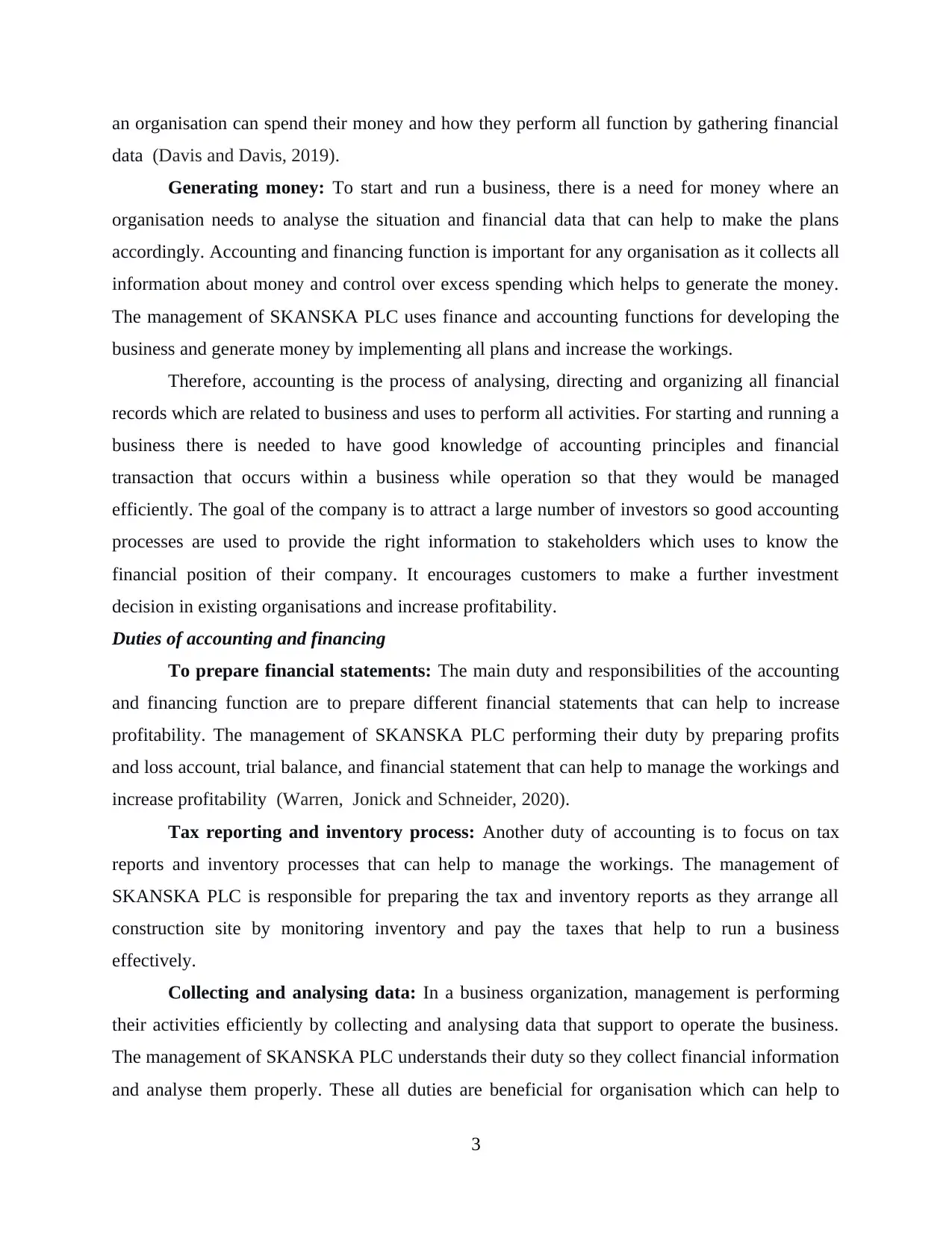
an organisation can spend their money and how they perform all function by gathering financial
data (Davis and Davis, 2019).
Generating money: To start and run a business, there is a need for money where an
organisation needs to analyse the situation and financial data that can help to make the plans
accordingly. Accounting and financing function is important for any organisation as it collects all
information about money and control over excess spending which helps to generate the money.
The management of SKANSKA PLC uses finance and accounting functions for developing the
business and generate money by implementing all plans and increase the workings.
Therefore, accounting is the process of analysing, directing and organizing all financial
records which are related to business and uses to perform all activities. For starting and running a
business there is needed to have good knowledge of accounting principles and financial
transaction that occurs within a business while operation so that they would be managed
efficiently. The goal of the company is to attract a large number of investors so good accounting
processes are used to provide the right information to stakeholders which uses to know the
financial position of their company. It encourages customers to make a further investment
decision in existing organisations and increase profitability.
Duties of accounting and financing
To prepare financial statements: The main duty and responsibilities of the accounting
and financing function are to prepare different financial statements that can help to increase
profitability. The management of SKANSKA PLC performing their duty by preparing profits
and loss account, trial balance, and financial statement that can help to manage the workings and
increase profitability (Warren, Jonick and Schneider, 2020).
Tax reporting and inventory process: Another duty of accounting is to focus on tax
reports and inventory processes that can help to manage the workings. The management of
SKANSKA PLC is responsible for preparing the tax and inventory reports as they arrange all
construction site by monitoring inventory and pay the taxes that help to run a business
effectively.
Collecting and analysing data: In a business organization, management is performing
their activities efficiently by collecting and analysing data that support to operate the business.
The management of SKANSKA PLC understands their duty so they collect financial information
and analyse them properly. These all duties are beneficial for organisation which can help to
3
data (Davis and Davis, 2019).
Generating money: To start and run a business, there is a need for money where an
organisation needs to analyse the situation and financial data that can help to make the plans
accordingly. Accounting and financing function is important for any organisation as it collects all
information about money and control over excess spending which helps to generate the money.
The management of SKANSKA PLC uses finance and accounting functions for developing the
business and generate money by implementing all plans and increase the workings.
Therefore, accounting is the process of analysing, directing and organizing all financial
records which are related to business and uses to perform all activities. For starting and running a
business there is needed to have good knowledge of accounting principles and financial
transaction that occurs within a business while operation so that they would be managed
efficiently. The goal of the company is to attract a large number of investors so good accounting
processes are used to provide the right information to stakeholders which uses to know the
financial position of their company. It encourages customers to make a further investment
decision in existing organisations and increase profitability.
Duties of accounting and financing
To prepare financial statements: The main duty and responsibilities of the accounting
and financing function are to prepare different financial statements that can help to increase
profitability. The management of SKANSKA PLC performing their duty by preparing profits
and loss account, trial balance, and financial statement that can help to manage the workings and
increase profitability (Warren, Jonick and Schneider, 2020).
Tax reporting and inventory process: Another duty of accounting is to focus on tax
reports and inventory processes that can help to manage the workings. The management of
SKANSKA PLC is responsible for preparing the tax and inventory reports as they arrange all
construction site by monitoring inventory and pay the taxes that help to run a business
effectively.
Collecting and analysing data: In a business organization, management is performing
their activities efficiently by collecting and analysing data that support to operate the business.
The management of SKANSKA PLC understands their duty so they collect financial information
and analyse them properly. These all duties are beneficial for organisation which can help to
3

increase the workings and attain the business goals (Salamatian, Shlezinger, Eldar and Médard,
2019).
Importance of duties in accounting and finance
In any industry whether small or large, required for management to understand their
duties and responsibilities in relation to business which can help to perform well and increase the
profitability. If duties are performed in well manner then it would be great opportunity for
business to increase their sales and productivity by managing all activities. In context to
SKANSKA PLC, duty of accounting and finance department is to identify all financial
transaction which have occurred in organisation and analyse them properly. This helps to review
that where organisation's money went and how it would be manage. Accounting and financial
function uses to create the good value of business by arranging all income and expenses that
occurred in workings.
Roles in SKANSKA PLC
Accounting and finance play an important role in SKANSKA PLC as it analysis the
financial information, controlling income and expenses, managing activities, and delivering the
best services which help to increase the profitability. The description of accounting and finance
role in the selected organization are as described:
Obeying the law: If an organisation is following accounting standards and principles
then it becomes an opportunity for business to increase its profitability. Accounting and finance
play a role of good management in SKANSKA PLC where all regulations are followed by
finance manager while running a business that helps to run a business successfully.
Creating a budget and financial records: For growing a business there is a need to
create a budget and maintain financial records which are important for increasing productivity.
Budgets are the blueprint that is prepared by management of SKANSKA PLC by involving
financial records and data that role uses to keeping proper records and building business stability
(Role of accounting and Finance in organisation, 2020).
Developing business strategy: The aim of every firm is to make a profit where strategy
is needed to develop business activities by managing all tasks. In SKANSKA PLC, the role of
accounting and finance is to develop the business strategy by identifying goals and formulate
planning which can help to operate a business regularly and complete the work on time. This can
4
2019).
Importance of duties in accounting and finance
In any industry whether small or large, required for management to understand their
duties and responsibilities in relation to business which can help to perform well and increase the
profitability. If duties are performed in well manner then it would be great opportunity for
business to increase their sales and productivity by managing all activities. In context to
SKANSKA PLC, duty of accounting and finance department is to identify all financial
transaction which have occurred in organisation and analyse them properly. This helps to review
that where organisation's money went and how it would be manage. Accounting and financial
function uses to create the good value of business by arranging all income and expenses that
occurred in workings.
Roles in SKANSKA PLC
Accounting and finance play an important role in SKANSKA PLC as it analysis the
financial information, controlling income and expenses, managing activities, and delivering the
best services which help to increase the profitability. The description of accounting and finance
role in the selected organization are as described:
Obeying the law: If an organisation is following accounting standards and principles
then it becomes an opportunity for business to increase its profitability. Accounting and finance
play a role of good management in SKANSKA PLC where all regulations are followed by
finance manager while running a business that helps to run a business successfully.
Creating a budget and financial records: For growing a business there is a need to
create a budget and maintain financial records which are important for increasing productivity.
Budgets are the blueprint that is prepared by management of SKANSKA PLC by involving
financial records and data that role uses to keeping proper records and building business stability
(Role of accounting and Finance in organisation, 2020).
Developing business strategy: The aim of every firm is to make a profit where strategy
is needed to develop business activities by managing all tasks. In SKANSKA PLC, the role of
accounting and finance is to develop the business strategy by identifying goals and formulate
planning which can help to operate a business regularly and complete the work on time. This can
4
⊘ This is a preview!⊘
Do you want full access?
Subscribe today to unlock all pages.

Trusted by 1+ million students worldwide
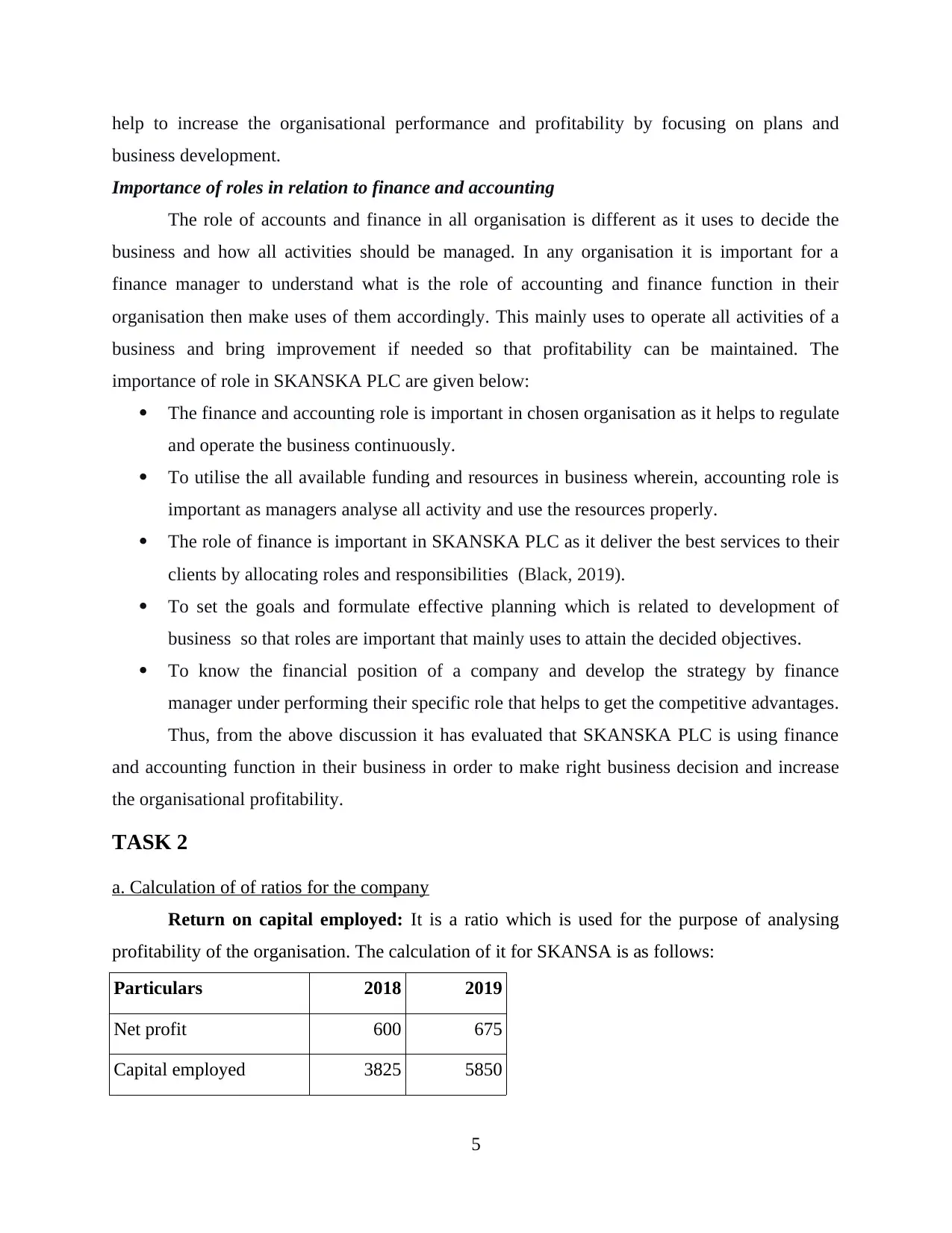
help to increase the organisational performance and profitability by focusing on plans and
business development.
Importance of roles in relation to finance and accounting
The role of accounts and finance in all organisation is different as it uses to decide the
business and how all activities should be managed. In any organisation it is important for a
finance manager to understand what is the role of accounting and finance function in their
organisation then make uses of them accordingly. This mainly uses to operate all activities of a
business and bring improvement if needed so that profitability can be maintained. The
importance of role in SKANSKA PLC are given below:
The finance and accounting role is important in chosen organisation as it helps to regulate
and operate the business continuously.
To utilise the all available funding and resources in business wherein, accounting role is
important as managers analyse all activity and use the resources properly.
The role of finance is important in SKANSKA PLC as it deliver the best services to their
clients by allocating roles and responsibilities (Black, 2019).
To set the goals and formulate effective planning which is related to development of
business so that roles are important that mainly uses to attain the decided objectives.
To know the financial position of a company and develop the strategy by finance
manager under performing their specific role that helps to get the competitive advantages.
Thus, from the above discussion it has evaluated that SKANSKA PLC is using finance
and accounting function in their business in order to make right business decision and increase
the organisational profitability.
TASK 2
a. Calculation of of ratios for the company
Return on capital employed: It is a ratio which is used for the purpose of analysing
profitability of the organisation. The calculation of it for SKANSA is as follows:
Particulars 2018 2019
Net profit 600 675
Capital employed 3825 5850
5
business development.
Importance of roles in relation to finance and accounting
The role of accounts and finance in all organisation is different as it uses to decide the
business and how all activities should be managed. In any organisation it is important for a
finance manager to understand what is the role of accounting and finance function in their
organisation then make uses of them accordingly. This mainly uses to operate all activities of a
business and bring improvement if needed so that profitability can be maintained. The
importance of role in SKANSKA PLC are given below:
The finance and accounting role is important in chosen organisation as it helps to regulate
and operate the business continuously.
To utilise the all available funding and resources in business wherein, accounting role is
important as managers analyse all activity and use the resources properly.
The role of finance is important in SKANSKA PLC as it deliver the best services to their
clients by allocating roles and responsibilities (Black, 2019).
To set the goals and formulate effective planning which is related to development of
business so that roles are important that mainly uses to attain the decided objectives.
To know the financial position of a company and develop the strategy by finance
manager under performing their specific role that helps to get the competitive advantages.
Thus, from the above discussion it has evaluated that SKANSKA PLC is using finance
and accounting function in their business in order to make right business decision and increase
the organisational profitability.
TASK 2
a. Calculation of of ratios for the company
Return on capital employed: It is a ratio which is used for the purpose of analysing
profitability of the organisation. The calculation of it for SKANSA is as follows:
Particulars 2018 2019
Net profit 600 675
Capital employed 3825 5850
5
Paraphrase This Document
Need a fresh take? Get an instant paraphrase of this document with our AI Paraphraser

Result 15.69 11.54
Net profit margin: This ratio is used for the purpose of analysing the ability of the entity
to generate profits against sales. All the calculations of it for SKANSA PLC are as follows:
Particulars 2018 2019
Net profit 600 675
Sales 4800 6000
Result 12.5 11.25
Current ratio: It is mainly used to determine liquidity of the enterprise so that it could
be assessed that the short term obligations could be met within one year or not. For SKANSA
calculation of it are as follows:
Particulars 2018 2019
Current assets 1515 2070
Current liabilities 645 2220
Result 2.35 0.93
Average Receivable days/ Debtors collection period: It is mainly related to the
assessment of the days in which the outstanding amounts from the clients could be recovered
(Bouzguenda, 2018). The calculations of it for SKANSA PLC are as follows:
Particulars 2018 2019
Account receivables 900 1200
Annual total sale 4800 6000
Result 68.44 73
Average Payable days/ Creditors collection period: This ratio is mainly used to
determine the time period which will be required by the entity to make payment of all the owed
amount to the creditors. All the calculations for the determination of it for SKANSA PLC are as
follows:
Particulars 2018 2019
Account payables 570 2100
6
Net profit margin: This ratio is used for the purpose of analysing the ability of the entity
to generate profits against sales. All the calculations of it for SKANSA PLC are as follows:
Particulars 2018 2019
Net profit 600 675
Sales 4800 6000
Result 12.5 11.25
Current ratio: It is mainly used to determine liquidity of the enterprise so that it could
be assessed that the short term obligations could be met within one year or not. For SKANSA
calculation of it are as follows:
Particulars 2018 2019
Current assets 1515 2070
Current liabilities 645 2220
Result 2.35 0.93
Average Receivable days/ Debtors collection period: It is mainly related to the
assessment of the days in which the outstanding amounts from the clients could be recovered
(Bouzguenda, 2018). The calculations of it for SKANSA PLC are as follows:
Particulars 2018 2019
Account receivables 900 1200
Annual total sale 4800 6000
Result 68.44 73
Average Payable days/ Creditors collection period: This ratio is mainly used to
determine the time period which will be required by the entity to make payment of all the owed
amount to the creditors. All the calculations for the determination of it for SKANSA PLC are as
follows:
Particulars 2018 2019
Account payables 570 2100
6
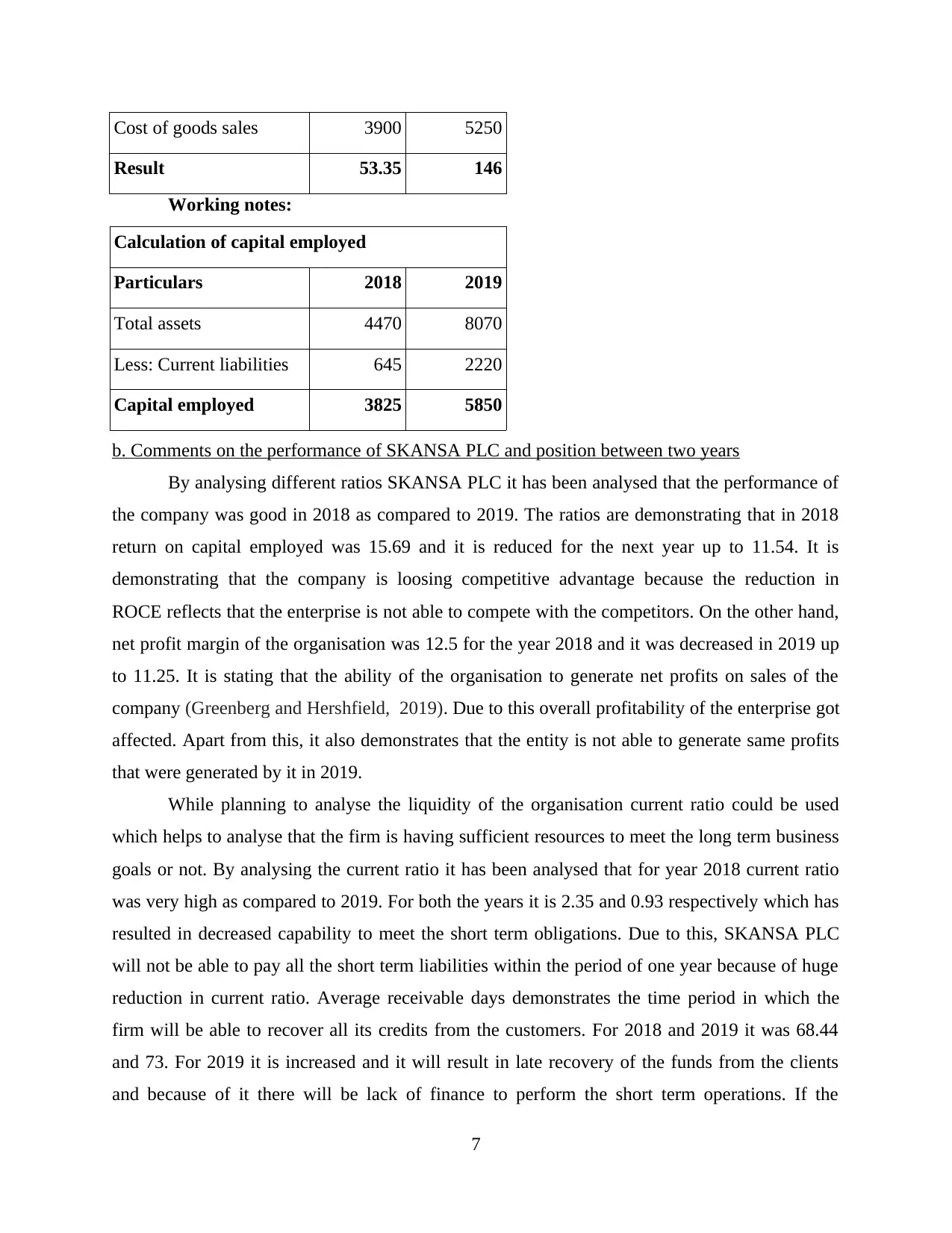
Cost of goods sales 3900 5250
Result 53.35 146
Working notes:
Calculation of capital employed
Particulars 2018 2019
Total assets 4470 8070
Less: Current liabilities 645 2220
Capital employed 3825 5850
b. Comments on the performance of SKANSA PLC and position between two years
By analysing different ratios SKANSA PLC it has been analysed that the performance of
the company was good in 2018 as compared to 2019. The ratios are demonstrating that in 2018
return on capital employed was 15.69 and it is reduced for the next year up to 11.54. It is
demonstrating that the company is loosing competitive advantage because the reduction in
ROCE reflects that the enterprise is not able to compete with the competitors. On the other hand,
net profit margin of the organisation was 12.5 for the year 2018 and it was decreased in 2019 up
to 11.25. It is stating that the ability of the organisation to generate net profits on sales of the
company (Greenberg and Hershfield, 2019). Due to this overall profitability of the enterprise got
affected. Apart from this, it also demonstrates that the entity is not able to generate same profits
that were generated by it in 2019.
While planning to analyse the liquidity of the organisation current ratio could be used
which helps to analyse that the firm is having sufficient resources to meet the long term business
goals or not. By analysing the current ratio it has been analysed that for year 2018 current ratio
was very high as compared to 2019. For both the years it is 2.35 and 0.93 respectively which has
resulted in decreased capability to meet the short term obligations. Due to this, SKANSA PLC
will not be able to pay all the short term liabilities within the period of one year because of huge
reduction in current ratio. Average receivable days demonstrates the time period in which the
firm will be able to recover all its credits from the customers. For 2018 and 2019 it was 68.44
and 73. For 2019 it is increased and it will result in late recovery of the funds from the clients
and because of it there will be lack of finance to perform the short term operations. If the
7
Result 53.35 146
Working notes:
Calculation of capital employed
Particulars 2018 2019
Total assets 4470 8070
Less: Current liabilities 645 2220
Capital employed 3825 5850
b. Comments on the performance of SKANSA PLC and position between two years
By analysing different ratios SKANSA PLC it has been analysed that the performance of
the company was good in 2018 as compared to 2019. The ratios are demonstrating that in 2018
return on capital employed was 15.69 and it is reduced for the next year up to 11.54. It is
demonstrating that the company is loosing competitive advantage because the reduction in
ROCE reflects that the enterprise is not able to compete with the competitors. On the other hand,
net profit margin of the organisation was 12.5 for the year 2018 and it was decreased in 2019 up
to 11.25. It is stating that the ability of the organisation to generate net profits on sales of the
company (Greenberg and Hershfield, 2019). Due to this overall profitability of the enterprise got
affected. Apart from this, it also demonstrates that the entity is not able to generate same profits
that were generated by it in 2019.
While planning to analyse the liquidity of the organisation current ratio could be used
which helps to analyse that the firm is having sufficient resources to meet the long term business
goals or not. By analysing the current ratio it has been analysed that for year 2018 current ratio
was very high as compared to 2019. For both the years it is 2.35 and 0.93 respectively which has
resulted in decreased capability to meet the short term obligations. Due to this, SKANSA PLC
will not be able to pay all the short term liabilities within the period of one year because of huge
reduction in current ratio. Average receivable days demonstrates the time period in which the
firm will be able to recover all its credits from the customers. For 2018 and 2019 it was 68.44
and 73. For 2019 it is increased and it will result in late recovery of the funds from the clients
and because of it there will be lack of finance to perform the short term operations. If the
7
⊘ This is a preview!⊘
Do you want full access?
Subscribe today to unlock all pages.

Trusted by 1+ million students worldwide
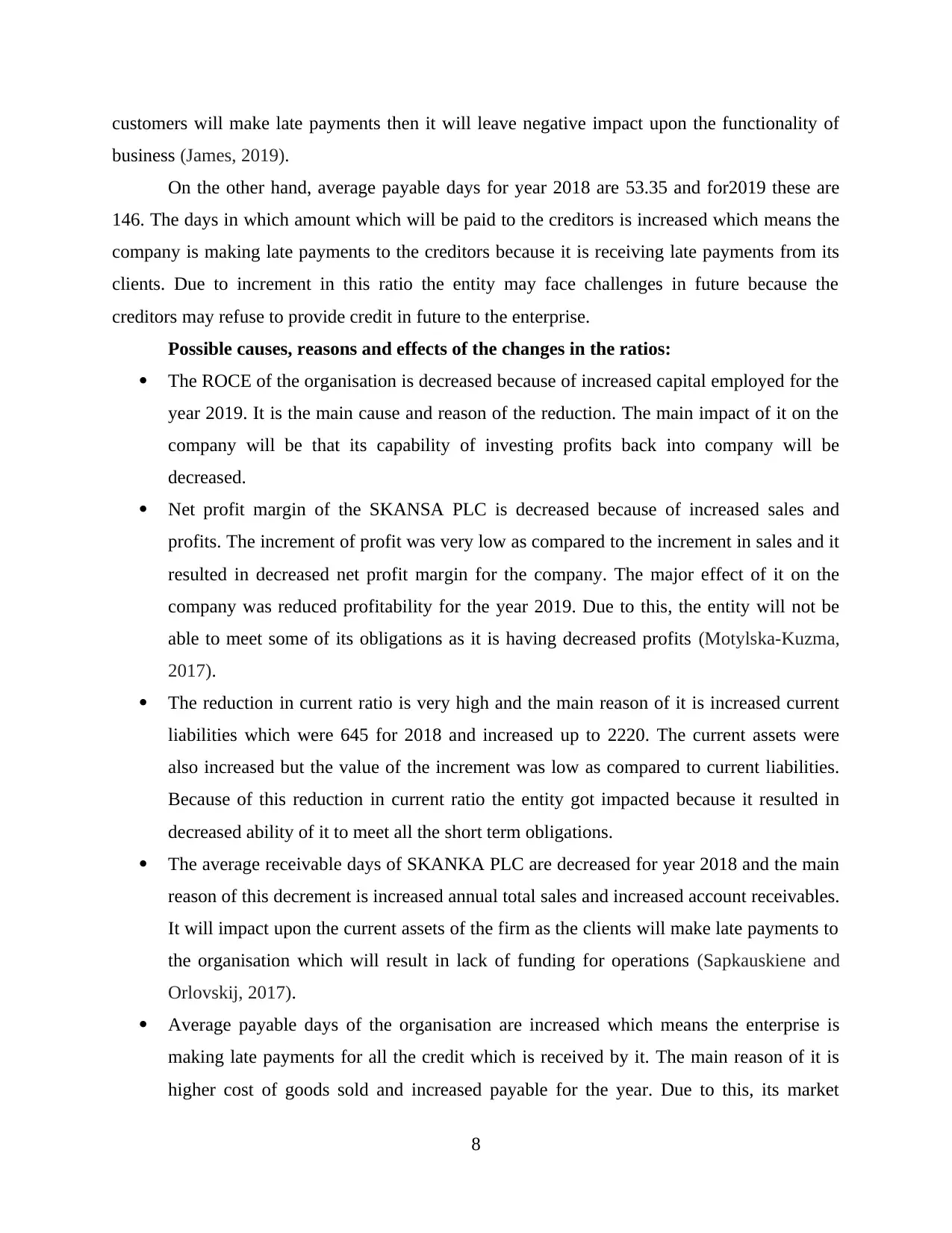
customers will make late payments then it will leave negative impact upon the functionality of
business (James, 2019).
On the other hand, average payable days for year 2018 are 53.35 and for2019 these are
146. The days in which amount which will be paid to the creditors is increased which means the
company is making late payments to the creditors because it is receiving late payments from its
clients. Due to increment in this ratio the entity may face challenges in future because the
creditors may refuse to provide credit in future to the enterprise.
Possible causes, reasons and effects of the changes in the ratios:
The ROCE of the organisation is decreased because of increased capital employed for the
year 2019. It is the main cause and reason of the reduction. The main impact of it on the
company will be that its capability of investing profits back into company will be
decreased.
Net profit margin of the SKANSA PLC is decreased because of increased sales and
profits. The increment of profit was very low as compared to the increment in sales and it
resulted in decreased net profit margin for the company. The major effect of it on the
company was reduced profitability for the year 2019. Due to this, the entity will not be
able to meet some of its obligations as it is having decreased profits (Motylska-Kuzma,
2017).
The reduction in current ratio is very high and the main reason of it is increased current
liabilities which were 645 for 2018 and increased up to 2220. The current assets were
also increased but the value of the increment was low as compared to current liabilities.
Because of this reduction in current ratio the entity got impacted because it resulted in
decreased ability of it to meet all the short term obligations.
The average receivable days of SKANKA PLC are decreased for year 2018 and the main
reason of this decrement is increased annual total sales and increased account receivables.
It will impact upon the current assets of the firm as the clients will make late payments to
the organisation which will result in lack of funding for operations (Sapkauskiene and
Orlovskij, 2017).
Average payable days of the organisation are increased which means the enterprise is
making late payments for all the credit which is received by it. The main reason of it is
higher cost of goods sold and increased payable for the year. Due to this, its market
8
business (James, 2019).
On the other hand, average payable days for year 2018 are 53.35 and for2019 these are
146. The days in which amount which will be paid to the creditors is increased which means the
company is making late payments to the creditors because it is receiving late payments from its
clients. Due to increment in this ratio the entity may face challenges in future because the
creditors may refuse to provide credit in future to the enterprise.
Possible causes, reasons and effects of the changes in the ratios:
The ROCE of the organisation is decreased because of increased capital employed for the
year 2019. It is the main cause and reason of the reduction. The main impact of it on the
company will be that its capability of investing profits back into company will be
decreased.
Net profit margin of the SKANSA PLC is decreased because of increased sales and
profits. The increment of profit was very low as compared to the increment in sales and it
resulted in decreased net profit margin for the company. The major effect of it on the
company was reduced profitability for the year 2019. Due to this, the entity will not be
able to meet some of its obligations as it is having decreased profits (Motylska-Kuzma,
2017).
The reduction in current ratio is very high and the main reason of it is increased current
liabilities which were 645 for 2018 and increased up to 2220. The current assets were
also increased but the value of the increment was low as compared to current liabilities.
Because of this reduction in current ratio the entity got impacted because it resulted in
decreased ability of it to meet all the short term obligations.
The average receivable days of SKANKA PLC are decreased for year 2018 and the main
reason of this decrement is increased annual total sales and increased account receivables.
It will impact upon the current assets of the firm as the clients will make late payments to
the organisation which will result in lack of funding for operations (Sapkauskiene and
Orlovskij, 2017).
Average payable days of the organisation are increased which means the enterprise is
making late payments for all the credit which is received by it. The main reason of it is
higher cost of goods sold and increased payable for the year. Due to this, its market
8
Paraphrase This Document
Need a fresh take? Get an instant paraphrase of this document with our AI Paraphraser
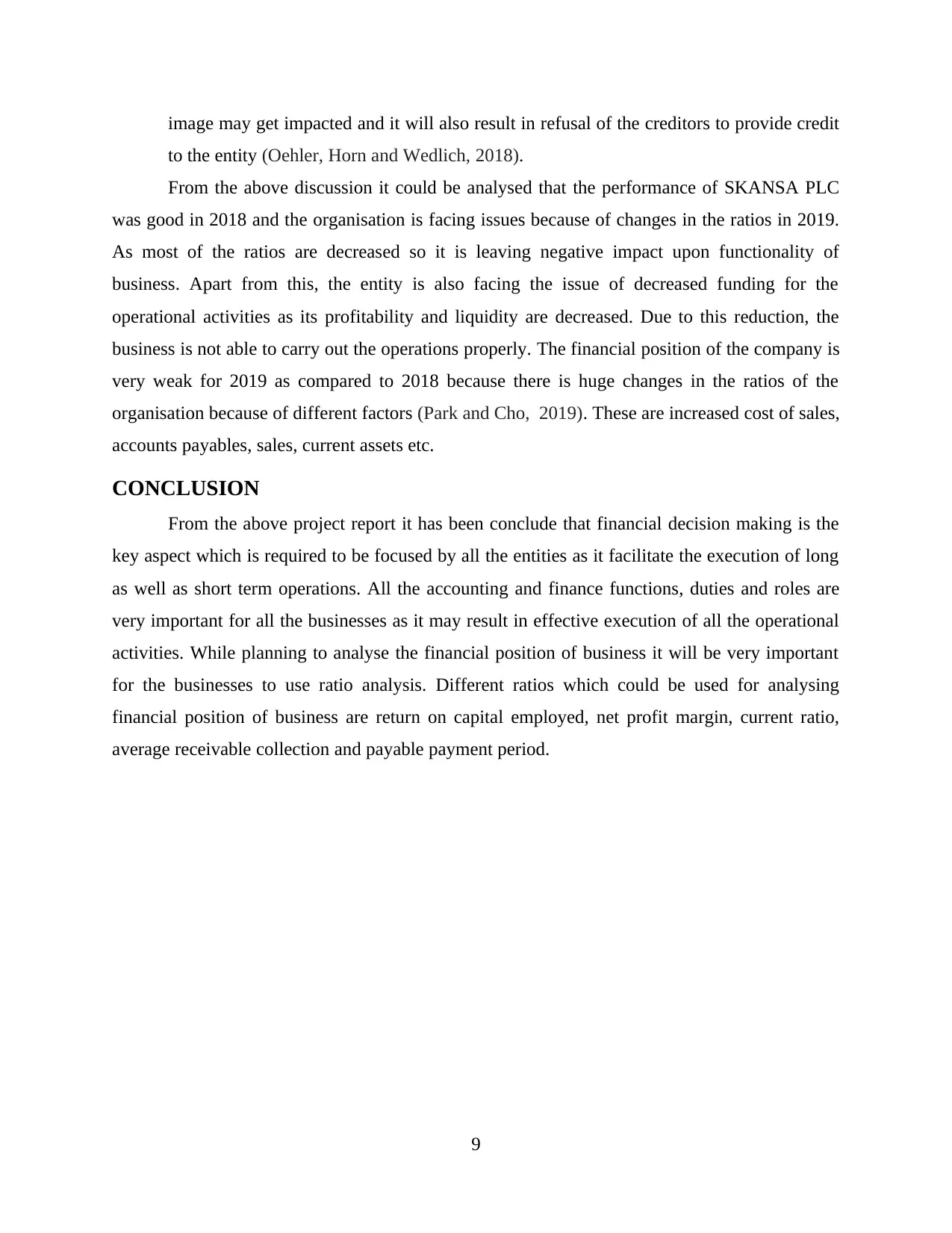
image may get impacted and it will also result in refusal of the creditors to provide credit
to the entity (Oehler, Horn and Wedlich, 2018).
From the above discussion it could be analysed that the performance of SKANSA PLC
was good in 2018 and the organisation is facing issues because of changes in the ratios in 2019.
As most of the ratios are decreased so it is leaving negative impact upon functionality of
business. Apart from this, the entity is also facing the issue of decreased funding for the
operational activities as its profitability and liquidity are decreased. Due to this reduction, the
business is not able to carry out the operations properly. The financial position of the company is
very weak for 2019 as compared to 2018 because there is huge changes in the ratios of the
organisation because of different factors (Park and Cho, 2019). These are increased cost of sales,
accounts payables, sales, current assets etc.
CONCLUSION
From the above project report it has been conclude that financial decision making is the
key aspect which is required to be focused by all the entities as it facilitate the execution of long
as well as short term operations. All the accounting and finance functions, duties and roles are
very important for all the businesses as it may result in effective execution of all the operational
activities. While planning to analyse the financial position of business it will be very important
for the businesses to use ratio analysis. Different ratios which could be used for analysing
financial position of business are return on capital employed, net profit margin, current ratio,
average receivable collection and payable payment period.
9
to the entity (Oehler, Horn and Wedlich, 2018).
From the above discussion it could be analysed that the performance of SKANSA PLC
was good in 2018 and the organisation is facing issues because of changes in the ratios in 2019.
As most of the ratios are decreased so it is leaving negative impact upon functionality of
business. Apart from this, the entity is also facing the issue of decreased funding for the
operational activities as its profitability and liquidity are decreased. Due to this reduction, the
business is not able to carry out the operations properly. The financial position of the company is
very weak for 2019 as compared to 2018 because there is huge changes in the ratios of the
organisation because of different factors (Park and Cho, 2019). These are increased cost of sales,
accounts payables, sales, current assets etc.
CONCLUSION
From the above project report it has been conclude that financial decision making is the
key aspect which is required to be focused by all the entities as it facilitate the execution of long
as well as short term operations. All the accounting and finance functions, duties and roles are
very important for all the businesses as it may result in effective execution of all the operational
activities. While planning to analyse the financial position of business it will be very important
for the businesses to use ratio analysis. Different ratios which could be used for analysing
financial position of business are return on capital employed, net profit margin, current ratio,
average receivable collection and payable payment period.
9
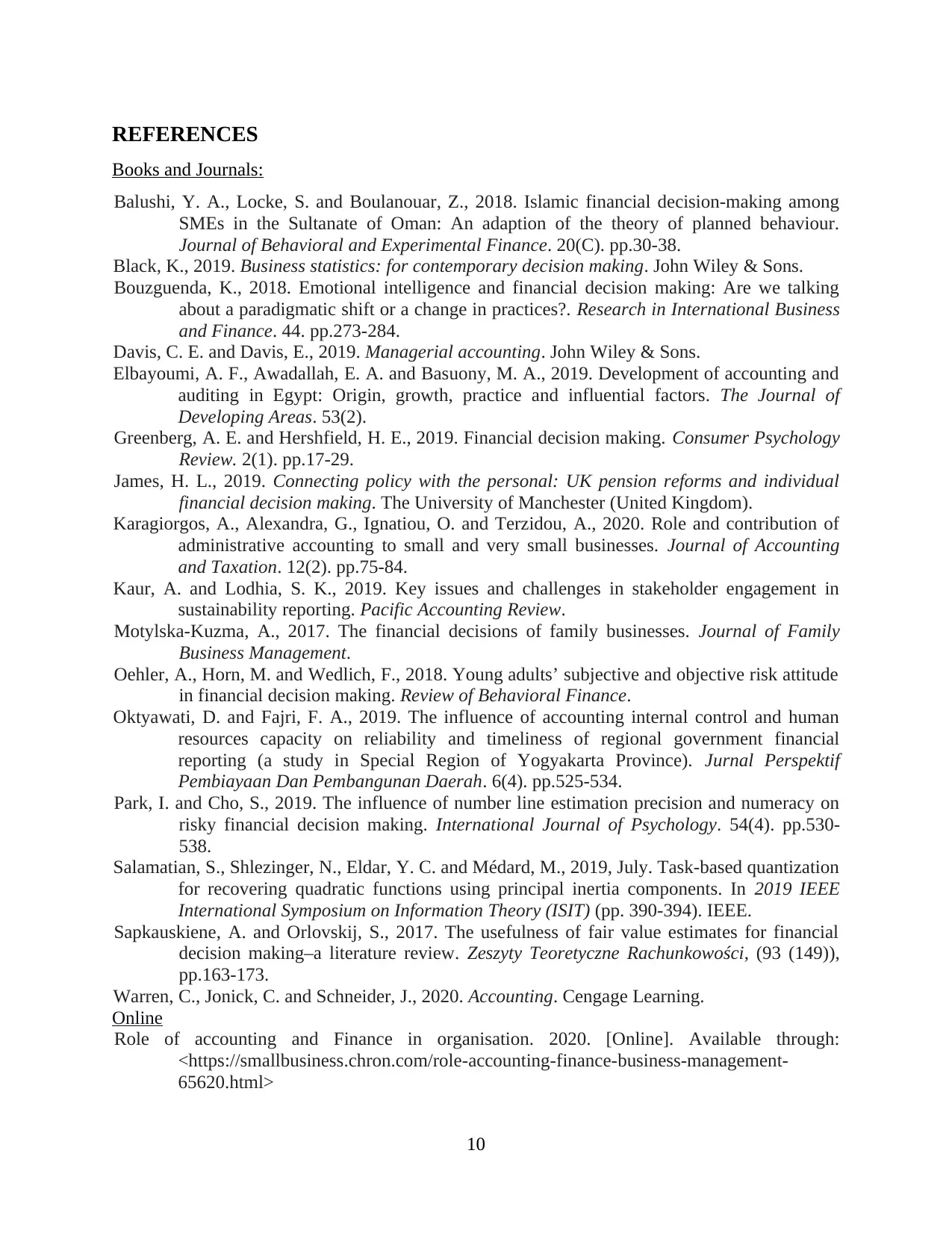
REFERENCES
Books and Journals:
Balushi, Y. A., Locke, S. and Boulanouar, Z., 2018. Islamic financial decision-making among
SMEs in the Sultanate of Oman: An adaption of the theory of planned behaviour.
Journal of Behavioral and Experimental Finance. 20(C). pp.30-38.
Black, K., 2019. Business statistics: for contemporary decision making. John Wiley & Sons.
Bouzguenda, K., 2018. Emotional intelligence and financial decision making: Are we talking
about a paradigmatic shift or a change in practices?. Research in International Business
and Finance. 44. pp.273-284.
Davis, C. E. and Davis, E., 2019. Managerial accounting. John Wiley & Sons.
Elbayoumi, A. F., Awadallah, E. A. and Basuony, M. A., 2019. Development of accounting and
auditing in Egypt: Origin, growth, practice and influential factors. The Journal of
Developing Areas. 53(2).
Greenberg, A. E. and Hershfield, H. E., 2019. Financial decision making. Consumer Psychology
Review. 2(1). pp.17-29.
James, H. L., 2019. Connecting policy with the personal: UK pension reforms and individual
financial decision making. The University of Manchester (United Kingdom).
Karagiorgos, A., Alexandra, G., Ignatiou, O. and Terzidou, A., 2020. Role and contribution of
administrative accounting to small and very small businesses. Journal of Accounting
and Taxation. 12(2). pp.75-84.
Kaur, A. and Lodhia, S. K., 2019. Key issues and challenges in stakeholder engagement in
sustainability reporting. Pacific Accounting Review.
Motylska-Kuzma, A., 2017. The financial decisions of family businesses. Journal of Family
Business Management.
Oehler, A., Horn, M. and Wedlich, F., 2018. Young adults’ subjective and objective risk attitude
in financial decision making. Review of Behavioral Finance.
Oktyawati, D. and Fajri, F. A., 2019. The influence of accounting internal control and human
resources capacity on reliability and timeliness of regional government financial
reporting (a study in Special Region of Yogyakarta Province). Jurnal Perspektif
Pembiayaan Dan Pembangunan Daerah. 6(4). pp.525-534.
Park, I. and Cho, S., 2019. The influence of number line estimation precision and numeracy on
risky financial decision making. International Journal of Psychology. 54(4). pp.530-
538.
Salamatian, S., Shlezinger, N., Eldar, Y. C. and Médard, M., 2019, July. Task-based quantization
for recovering quadratic functions using principal inertia components. In 2019 IEEE
International Symposium on Information Theory (ISIT) (pp. 390-394). IEEE.
Sapkauskiene, A. and Orlovskij, S., 2017. The usefulness of fair value estimates for financial
decision making–a literature review. Zeszyty Teoretyczne Rachunkowości, (93 (149)),
pp.163-173.
Warren, C., Jonick, C. and Schneider, J., 2020. Accounting. Cengage Learning.
Online
Role of accounting and Finance in organisation. 2020. [Online]. Available through:
<https://smallbusiness.chron.com/role-accounting-finance-business-management-
65620.html>
10
Books and Journals:
Balushi, Y. A., Locke, S. and Boulanouar, Z., 2018. Islamic financial decision-making among
SMEs in the Sultanate of Oman: An adaption of the theory of planned behaviour.
Journal of Behavioral and Experimental Finance. 20(C). pp.30-38.
Black, K., 2019. Business statistics: for contemporary decision making. John Wiley & Sons.
Bouzguenda, K., 2018. Emotional intelligence and financial decision making: Are we talking
about a paradigmatic shift or a change in practices?. Research in International Business
and Finance. 44. pp.273-284.
Davis, C. E. and Davis, E., 2019. Managerial accounting. John Wiley & Sons.
Elbayoumi, A. F., Awadallah, E. A. and Basuony, M. A., 2019. Development of accounting and
auditing in Egypt: Origin, growth, practice and influential factors. The Journal of
Developing Areas. 53(2).
Greenberg, A. E. and Hershfield, H. E., 2019. Financial decision making. Consumer Psychology
Review. 2(1). pp.17-29.
James, H. L., 2019. Connecting policy with the personal: UK pension reforms and individual
financial decision making. The University of Manchester (United Kingdom).
Karagiorgos, A., Alexandra, G., Ignatiou, O. and Terzidou, A., 2020. Role and contribution of
administrative accounting to small and very small businesses. Journal of Accounting
and Taxation. 12(2). pp.75-84.
Kaur, A. and Lodhia, S. K., 2019. Key issues and challenges in stakeholder engagement in
sustainability reporting. Pacific Accounting Review.
Motylska-Kuzma, A., 2017. The financial decisions of family businesses. Journal of Family
Business Management.
Oehler, A., Horn, M. and Wedlich, F., 2018. Young adults’ subjective and objective risk attitude
in financial decision making. Review of Behavioral Finance.
Oktyawati, D. and Fajri, F. A., 2019. The influence of accounting internal control and human
resources capacity on reliability and timeliness of regional government financial
reporting (a study in Special Region of Yogyakarta Province). Jurnal Perspektif
Pembiayaan Dan Pembangunan Daerah. 6(4). pp.525-534.
Park, I. and Cho, S., 2019. The influence of number line estimation precision and numeracy on
risky financial decision making. International Journal of Psychology. 54(4). pp.530-
538.
Salamatian, S., Shlezinger, N., Eldar, Y. C. and Médard, M., 2019, July. Task-based quantization
for recovering quadratic functions using principal inertia components. In 2019 IEEE
International Symposium on Information Theory (ISIT) (pp. 390-394). IEEE.
Sapkauskiene, A. and Orlovskij, S., 2017. The usefulness of fair value estimates for financial
decision making–a literature review. Zeszyty Teoretyczne Rachunkowości, (93 (149)),
pp.163-173.
Warren, C., Jonick, C. and Schneider, J., 2020. Accounting. Cengage Learning.
Online
Role of accounting and Finance in organisation. 2020. [Online]. Available through:
<https://smallbusiness.chron.com/role-accounting-finance-business-management-
65620.html>
10
⊘ This is a preview!⊘
Do you want full access?
Subscribe today to unlock all pages.

Trusted by 1+ million students worldwide
1 out of 13
Related Documents
Your All-in-One AI-Powered Toolkit for Academic Success.
+13062052269
info@desklib.com
Available 24*7 on WhatsApp / Email
![[object Object]](/_next/static/media/star-bottom.7253800d.svg)
Unlock your academic potential
Copyright © 2020–2025 A2Z Services. All Rights Reserved. Developed and managed by ZUCOL.





